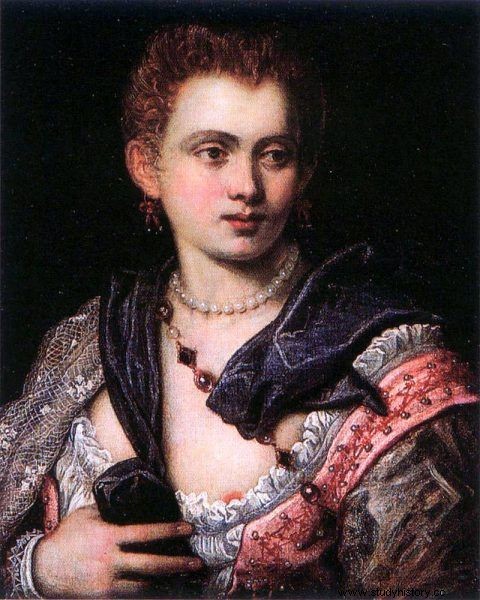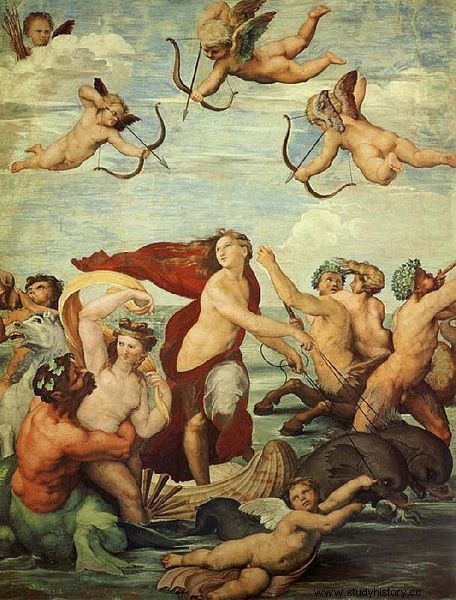Intellectuals, rich women, muses - queens of the night. One kiss of them cost a fortune. They made Italy famous during the Renaissance. Meet the 3 most famous Italian prostitutes.
To this day, the infamous brothels are controversial and difficult to understand. Interestingly, in the Renaissance, prostitution was not a big taboo subject, and well-educated, influential courtesans turned around in the highest circles and accumulated dizzying fortunes .
According to the census of 1409, there was one prostitute for every twelve inhabitants of Rome. In the heyday of culture and art, these women took care of their education and manners, as they derived many benefits from “being in company”. The most refined and elegant of them cortigiane oste - noble courtesans - became lovers of princes and important personalities from the world of the church and became muse for artists . They were rich and independent, and they often received "devotees" at their own homes.
Tullia d'Aragona - daughter of the cardinal
One of the most interesting good Renaissance courtesans was Tullia. The artist, poet and philosopher was the daughter of a beautiful and influential prostitute and Cardinal Lodovico d'Aragona, who not only recognized the girl, gave her her surname, but also educated her and took care of her prosperous life. Tullia took music, singing and dancing lessons and learned foreign languages.
Her situation worsened after her father left Rome (the cardinal believed that the Borgias were planning to poison him). She traveled a little with her mother, arousing interest wherever she went. She charmed with dancing and singing, she was likened to Cleopatra herself.

Moretto da Brescia, Tullia d'Aragona as Salome
You could literally go crazy for a beautiful, talented mole. One of her rejected admirers pushed her in the chest with a dagger in an act of jealousy! The wound, however, was not fatal. Over the course of her life, she often struggled with jealousy - including that of other courtesans, who were to envy her beauty and success.
Tullia was portrayed by the Italian painter Moretto da Brescia.
Veronica Franco - poet and intellectual
Perhaps the most famous Italian courtesan was Veronica Franco - an outstanding intellectual, linguistically and musically gifted. Due to her gender, she could not accept an appropriate education, so she took full advantage of the opportunities offered by her profession. She joyfully participated in the male world of culture and science. She was eager to learn and despised ignorance . In a letter to one of her clients she wrote:
You know that all those who consider themselves capable of earning my love without sparing any efforts, diligently study the teachings. (...) If fate had allowed me, I would spend all my time in the peace and quiet of real husbands' academy.
Veronica was also a poet. She is the author of the poem Terze rime dedicated to Guglielm Gonzaga, Prince of Mantua, and numerous sonnets. In her literary work, she often took up women's topics, and was also active in supporting other prostitutes and their children.

Veronica Franco is one of the most famous Italian courtesans
She was well paid - a kiss from the famous courtesan cost four or five crowns (this was the amount the maid earned in ... six months), and the "full transaction" reached the price of fifty kronor.
Her person also inspired in later epochs. She was portrayed in the book by Margaret Rosenthal entitled The Honest Courtesan and in the film Dangerous Beauty based on it.
Imperia Cognati - Raphael's muse
Biaggio Pallai wrote about her:"God Mars gave the Romans an empire, and the goddess Venus gave an Empire." Imperia Cognati is one of the most famous and richest Renaissance courtesans. The circle of her admirers included representatives of Rome's elite - curia officials, cardinals, artists.
Empires lived in luxury. A German was supposed to pay a hundred kronor for one night with her! She was the owner of a huge, beautiful house where she received admirers. According to an anecdote, the Spanish client searched for a long time around the magnificent apartments for an ugly place to spit into. The only scrap turned out to be ... the face of a servant.
Her circle of friends was Rafael Santi himself, who immortalized her image several times. It was probably she who was portrayed in the painting "Sappho of Parnassus" and "The Triumph of Galatea", was also supposed to be Calliope in the Apostolic Palace. Raphael or one of his students is also credited with the portrait of Imperia as recumbent Venus, which adorns the entrance to the madrassa's house.

Imperia Cognati as "Galatea"
The circumstances of her death are shrouded in mystery. The courtesan probably committed suicide at a young age (it is estimated that she could have been from 26 to 31 at the time). She spent a considerable amount of her fortune on paving the Strada del Populo street in Rome. This is where the less fortunate 'colleagues' worked.
Mysterious and beautiful Italian mistresses aroused strong emotions. They fascinated and inspired. The English traveler Thomas Coryat, describing his trip to Venice, made a note:
The charms of these loving nymphs Calypso are so infinite that their fame attracted many to Venice from the most distant Christian lands. When you enter one of their palaces (...) you think you are entering the paradise of Venus. (...) The courtesan herself comes dressed up as a queen and goddess of love, and you would think that she has just arrived from Paphos, Cnidus or Cythera, the ancient abode of Lady Venus. For her face is decorated with the essence of beauty (...)
In a male-dominated world, the Italian courtesans built a position that they used for development that they could not count on otherwise.
The time of the famous meters, however, was coming to an end. It was because Pope Pius V made a decisive fight for them. But this is a topic for a completely different story.
Bibliography:
- Nickie Roberts, Whores in History. Prostitution in Western society, Wydawnictwo Alfa 1997,
- Monica Garcia Massaque, History of brothels. history of pleasure houses from antiquity to modern times, Bellona 2009
- Chłędowski K., Rome. People of Rebirth, "Book and Knowledge" Publishing House, 1996
